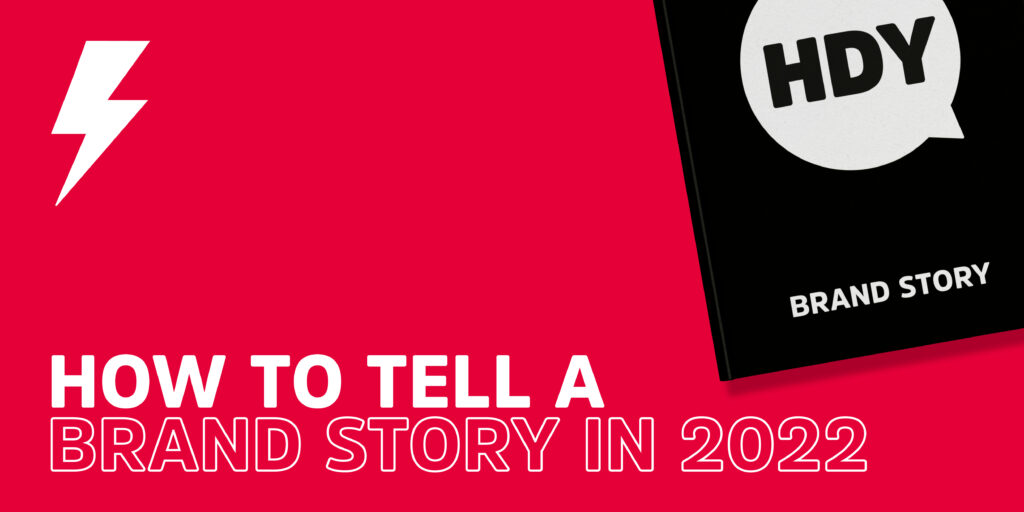How to Tell a Brand Story in 2022
8th September 2022
A brand story is no longer a nice to have; they’re going to be the difference between success and failure if not now, then very soon. As our buying habits and consumer trust continues to evolve, the way we interact with brands continues to move away from faceless corporate schtick and into the familiar realm of something we can all get on board with – humanity.

What is a brand story?
Let’s use a great example of a brand story to explain exactly what one is. Hiut denim may not be as well-known as Levi’s for example, but they have used a fantastic brand story as the basis of, well, their entire organisation.
When globalisation forced the denim factory in Cardigan, Ceredigion to close, the town was suddenly left with a gap in the job market. However, the skill set remained. Fast forward to the present, the denim factory is back open, creating bespoke denim crafted by ‘the best jeans makers in the world’.
Yes, the jeans look the same as Levi’s, and they cost a lot more, but consumers are buying into the story behind them. As well as getting a pair of hand-crafted jeans made by experts, you’re supporting a whole community and helping an established local cottage industry to thrive.
Smart, huh?
In this example, we’ve got history, we’ve got a good news story, a community coming back together all blended in with the bespoke, quality product and that’s exactly what a brand story should do! It’s all about talking about why what you do is so special, different or sustainable / great for your employees / the community around you.
Why storytelling has become so important
The trend away from buying from a company and buying instead from a person has been put in turbo mode thanks in part to social media. Influencers have allowed brand stories to have their own specific platform, and rather than traditional advertising, a human talking about the background or why they love a product or service is very familiar to consumers.
There’s also the steady trend of moving away from traditional branding, with the next generation of consumers not only interested in logos and features, but also how sustainable organisations are, their corporate social responsibility commitments, and other factors such as diverse hiring.
And what better way to show off these than with a story.
Our Step by step guide to creating a brand story
Now we’ve got a basis for what a brand story is and does, it’s time to craft your own. Here’s our handy step-by-step to identifying any sort of existing brand story, challenging it, and shaping it into something much more powerful.
- 1. Identify your current brand’s status quo
Start with a deep dive into your brand first. Identify what you currently share with your audience and, ideally, grab some feedback with help from surveys, social listening, or focus groups.
Then, ask yourself honestly if there’s already a great story there, and if you’re really talking about it in your marketing. If the answer is no on both counts, then it’s time to look at the next step.
- 2. See what resonates with your audience
Once you’ve identified your story (or lack of), it’s time to see if anyone gives a hoot!
It’s easy to think a great story, like the Hiut denim story, would generate instant buy-in from the market. But you can imagine the targeting and audience understanding that goes into a premium bespoke denim brand competing with global giants.
Often, identifying a brand story actually starts with the target market. Knowing what they like, don’t like, and what they want to see, is the secret to landing the story.
Again, use the same tools in the other direction, to learn not about your own brand perception, but what your potential target market likes and doesn’t like.
Look at your competitors, brands in the same ballpark as you, and be open-minded. It’s pointless creating an amazing story about all the money you’ve invested in your factory if your audience really doesn’t care about factories!
- 3. Find out your ‘why’
Watch this great video from Simon Sinek to understand what a ‘why’ is. Armed with this, you’ll be able to talk about the reason for your brand’s existence. Without this, it’s going to be really tough to build a story around your brand, as you’ll only ever talk about what you do and how you do it. And guess what? Your audience will be way more engaged with your ‘why’ than either of those!
- 4. Make sure your story sounds human
We’ve already talked about the human element being a key factor in your brand story, so don’t fall into the trap of building a brand story that sounds like the corporate section of your website.
Use real people from your organisation, real imagery, and ideally video to show ‘real life’ situations. Be conversational and consider using things like animation or a professional voiceover to build out your story and create something really engaging.
- 5. Ensure your brand story can be flexed
You need to make sure your brand story will work anywhere, anytime. Why? Because it needs to be visible on every platform and every digital and physical marketing outlet you use.
Make sure videos can be broken down into snippets and soundbites, choose images and a style that can be applied to anything and think about branding your brand story!
- 6. Don’t just focus on the highlights
Brand stories need to be deep and meaningful. This isn’t just a showreel of achievements. Be honest and show true emotion, even if that means talking about where you’ve come from, what you’ve been through, good and bad.
By being honest with your story and your vision, you’ll create that humanity that people buy into. So don’t be scared about being vulnerable; it’ll resonate with your audience.
- 7. Launch it properly
Brand stories should land with impact and be a key tool that gains traction and keeps rolling well into the future. It shouldn’t be seen as a short term strategy, so consider giving it the correct time and investment it needs.
Going in half-hearted will likely leave you with a potentially great story that remains unseen.
And remember to live it too. Don’t just create your brand story and forget about it. Champion it, make sure your people know about it and share it, and get it chiselled in stone on your website, across your digital channels and in your onboarding.
It doesn’t just have to be a marketing tool either – it could give you a great addition to your recruitment and onboarding collateral too.
Now you’ve got a framework for creating or updating your brand story, you stand a much better chance of engaging with your audience and making a more compelling reason for them to be interested in you, your product, or your service. Don’t forget to check out our top tips for engaging with influencers and how to jump on a bandwagon properly if you’re linking up your new brand story to a campaign!
If you want to see what a brand story looks like visualised, read out latest case study on Wasps Rugby here and see how our brand guidelines have applied to the Wasps website and social.

